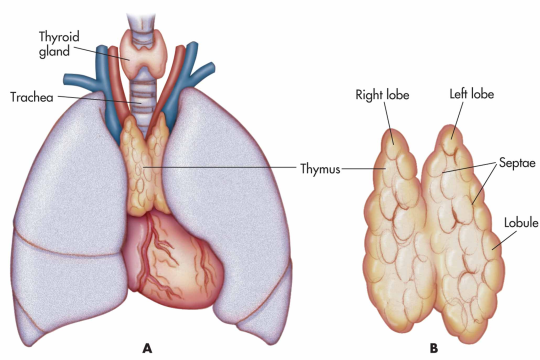#thymoma
Thethymus is a specialised primary lymphoid organ of the immune system.
- At its largest and most active during the neonatal and pre-adolescent periods.
- Decreases in size and activity through teenage years
- Thymus tissue is gradually replaced by adipose tissue(fat).
- Residual T lymphopoiesis continues throughout adult life.

The thymus is composed of two identical lobes and is located in the anterior superior mediastinum, in front of the heart and behind the sternum. Each lobe of the thymus can be divided into a central medulla and a peripheral cortex which is surrounded by an outer capsule.
Function
Facilitates the maturation of T cells - which provide cell-mediated immunity.
- T cells begin as hematopoietic precursors from the bone-marrow, and migrate to the thymus, where they are referred to as thymocytes.
- In the thymus they undergo a process to ensure the cells react against antigens (“positive selection”), but that they do not react against antigens found on body tissue(“negative selection”).
- Once mature, T cells emigrate from the thymus to provide vital functions in the immune system.
- Each T cell has a distinct T cell receptor, suited to a specific substance, called an antigen.
- Most T cell receptors bind to the major histocompatibility complex on cells of the body.
Positive selection
T cells have distinct T cell receptors. These are formed by process recombination gene rearrangement which is error-prone, and some thymocytes fail to make functional T-cell receptors, whereas other thymocytes make T-cell receptors that are autoreactive. The survival and nature of the T cell then depends on its interaction with surrounding thymic epithelial cells.
- T cell receptor interacts with the MHC molecules on the surface of epithelial cells.
- A T cell with a receptor that doesn’t react, or reacts weakly will die by apoptosis.
- A T cell that does react will survive and proliferate.
- A mature T cell expresses only CD4 or CD8, but not both.
Negative selection
T cells that attack the body’s own proteins are eliminated in the thymus. Epithelial cells in the medulla and dendritic cells in the thymus express major proteins from elsewhere in the body. Some CD4 positive T cells exposed to self antigens persist as T regulatory cells.
Pathology
Immunodeficiency - As the thymus is the organ of T-cell development, any congenital defect in thymic genesis or a defect in thymocyte development can lead to a profound T cell deficiency in primary immunodeficiency disease.
Autoimmune disease - Genetic disorders, such as Myasthenia gravis: caused by antibodies that block acetylcholine receptors.
Thymomas - Originate in thymic epithelial cells most often in adults older than 40. Generally detected when they cause symptoms, such as a neck mass or affecting nearby structures such as the superior vena cava. Can be benign; benign but by virtue of expansion, invading beyond the capsule of the thymus (“invasive thyoma”), or malignant (a carcinoma).
Lymphomas - Tumours originating from T cells of the thymus form a subset of acute lymphoblastic leukaemia (ALL)
Thymic cysts - The thymus may contain cysts, usually less than 4 cm in diameter. Thymic cysts are usually detected incidentally and do not generally cause symptoms.
